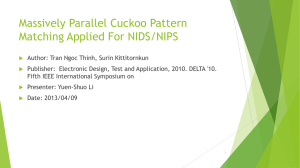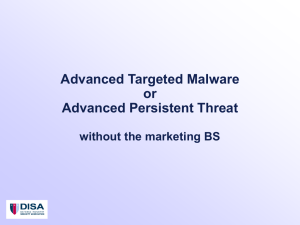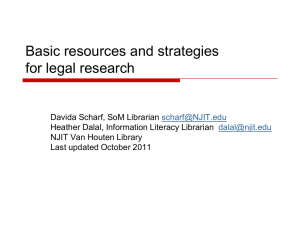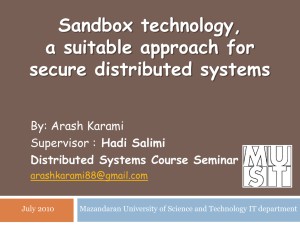Document 5272032
advertisement
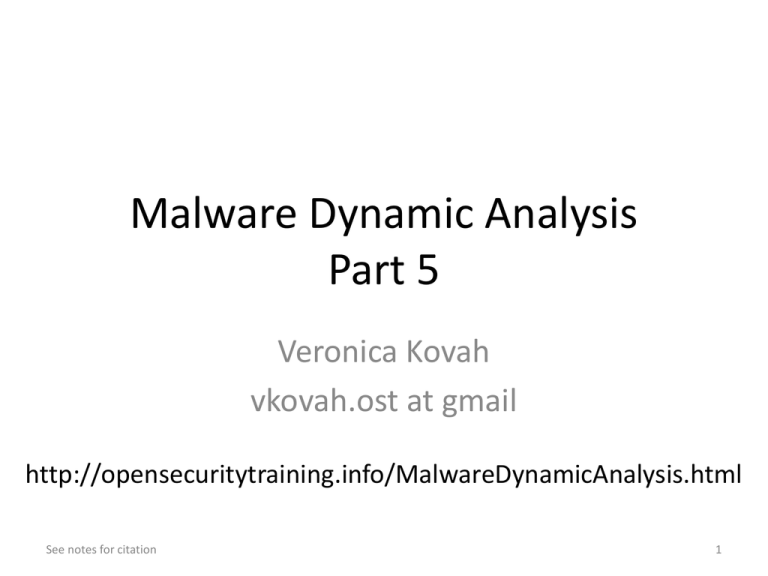
Malware Dynamic Analysis
Part 5
Veronica Kovah
vkovah.ost at gmail
http://opensecuritytraining.info/MalwareDynamicAnalysis.html
See notes for citation
1
All materials is licensed under a Creative
Commons “Share Alike” license
http://creativecommons.org/licenses/by-sa/3.0/
See notes for citation
2
Where are we at?
• Part 5: Using an all-in-one sandbox
– Cuckoo Sandbox
– Malware Attribute Enumeration and
Characterization (MAEC)
– Different sandbox results comparison
• Part 6: Actionable output
– Yara
– Snort
See notes for citation
3
Malware Analysis Sandbox
• Provides file system, registry keys, and network traffic
monitoring in controlled environment and produces a
well formed report
• Using a sandbox is more efficient and sometimes more
effective
• Configure your own sandbox such as Joebox, GFI
Sandbox, and Cuckoo Sandbox.
• Use public sandbox such as ThreatExpert, GFI
ThreatTrack, and Anubis
– Do not submit malware to a public
sandbox if it reveals sensitive information
about your organization and/or customer.
See notes for citation
4
Cuckoo Sandbox
•
•
•
•
Open source automated malware analysis system
Analyzes PE, PDF, MS Office, PHP scripts, etc.
Outputs JSON/HTML/MAEC reports
Customization
–
–
–
–
–
–
Machinery Modules: virtualization software
Analysis Package: how to conduct the analysis procedure
Processing Modules: how to analyze raw results
Signatures
Reporting Modules
Auxiliary Modules: to be executed in parallel to every
analysis
See notes for citation
5
Poison Ivy
• Revert the victim VM to “cuckoo” snapshot
• Open three terminals
• Terminal #1, run inetsim
– $ sudo inetsim
• Terminal #2, run Cuckoo Sandbox v1.0
1)
2)
3)
$ cd ~/MalwareClass/tools/cuckoo
Edit conf/auxiliary.conf (to sniff on vboxnet1)
$ python ./cuckoo.py
• Terminal #3, submit piagent.exe to Cuckoo
1)
2)
$ cd ~/MalwareClass/tools/cuckoo/utils
$ python
./submit.py~/MalwareClass/samples/PoisonIvy/piagent.exe
See notes for citation
6
Cuckoo Sandbox Results
• Task results are generated under
{Cuckoo Root}/storage/analysis/[task number]/
–
–
–
–
–
{Cuckoo Root} = ~/MalwareClass/tools/cuckoo
reports directory includes reports in different formats
logs directory includes raw data named <process id>.bson
shots directory includes screen shots
files directory includes dropped files. You can then run dropped
executables through on their own
• Submitted sample will be copied to
{Cuckoo Root}/storage/binaries/MD5NAME,
where MD5NAME is the md5 of the submitted sample
– A symbolic link (named binary) exists under the task result
directory
See notes for citation
7
Poison Ivy Results
• $ cd
~/MalwareClass/tools/cuckoo/storage/analysi
s/1/reports
• $ firefox report.html &
• $ gedit report.json &
• $ firefox report.maec-4.0.1.xml &
See notes for citation
8
Malware Attribute Enumeration and
Characterization (MAEC)
• “a standardized language for encoding and
communicating high-fidelity information
about malware based upon attributes such as
behaviors, artifacts, and attack patterns”
https://maec.mitre.org/about/index.html
• A standard is necessary to provide a common
way to share malware analysis results among
organizations to avoid duplicate, inaccurate
work
See notes for citation
9
MAEC (2)
• Supported tools
– Native: Cuckoo Sandbox
– Via a translator: Anubis,
ThreatTrack, ThreatExpert
• Would be very useful to
search openmalware.org
samples based on
attributes, could make a
new search engine:
“Ask MAEC!”
See notes for citation
10
Parite (1) – Cuckoo v1.0
• We will learn how to interpret a sandbox’s
results based on what we have learned so far
• Submit parite sample to Cuckoo Sandbox v1.0
1) $ cd ~/MalwareClass/tools/cuckoo/utils
2) $ python submit.py
~/MalwareClass/samples/parite/malware.exe
• Kill the cuckoo.py process with ctrl-c once the
analysis is done
See notes for citation
11
Parite (2) - Cuckoo v0.5
• Install Cuckoo Sandbox v0.5’s agent on the
victim VM
– Copy agent.py from the host machine to the
victim VM
• Use WinSCP on the victim VM
• It’s located at ~/Updates/cuckoo/agent/agent.py in the
host machine
• Open a DOS terminal and start the agent
C:\python27\python.exe c:\agent.py
– Make a snapshot with the name “cuckoo05”
See notes for citation
12
Parite (3) - Cuckoo v0.5
• Terminal #2, run Cuckoo Sandbox v0.5
1) $ cd ~/Updates/cuckoo
2) $ python ./cuckoo.py
• Terminal #3, submit parite sample to Cuckoo
1) $ cd ~/Updates/cuckoo/utils
2) $ python submit.py
~/MalwareClass/samples/parite/malware.exe
See notes for citation
13
Parite (4)
• Consult public sandbox results as well under
~/Updates/public_sandbox_results/parite/
•
•
•
anubis:
$ evince ./anubis/report.pdf
threatexpert: $ firefox ./threatexpert/report.html
threattrack: $ evince ./threattrack/analysis.pdf
Q1. (SKIP) Does this drop files with randomized names?
Q2. How does it persist?
Q3. How does it maneuver?
Q4. Does it have self-avoidance?
Q5. Does it self-destruct?
Q6. Where does it try to connect to?
See notes for citation
14
Answers for Parite Lab (1)
A2.
– Created “Run” registry value
HKLM\Software\Microsoft\Windows\CurrentVersi
on\RUN\fmsiocps
to “C:\Windows\fmsiocps.exe”
– Modified “AppInit_Dlls” registry value
HKLM\Software\Microsoft\Windows
NT\CurrentVesion\Windows\AppInit_Dlls
to “fmsiocps.dll”
See notes for citation
15
Answers for Parite Lab (2)
A3.
– Dll injection via AppInit_Dlls
– Dll injection using CreateRemoteThread() API
• OpenProcess (PID=1760)→VirtualAllocEx →
NtWriteVirtualMemory →CreateRemoteThread
• Now you are interested in the process name of PID 1760 :D
A4. Yes, mutex “Residented” is created
A5. Yes, the submitted sample file was deleted
A6. 192.5.5.241 (per ThreatExpert result)
See notes for citation
16
Nitol
• Consult “Parite” lab slides for how to submit the
sample to both versions of Cuckoo Sandbox and
answer the following questions about Nitol:
Q1. (SKIP) Does this drop files with randomized
names?
Q2. How does it persist?
Q3. How does it maneuver?
Q4. Does it have self-avoidance?
Q5. Does it do self-destruction?
Q6. Where does it try to connect to?
See notes for citation
17
Answers for Nitol (1)
A2.
1) Registered an auto-start service
– HKLM\System\CurrentControlSet\Services\Distrib
uijq
2) Created lpk.dll under multiple directories for
DLL search order hijacking; this technique
also makes the malware persistent
A3. DLL search order hijacking (lpk.dll)
See notes for citation
18
Answers for Nitol (2)
A4. Yes, Distribuijq (per ThreatExpert result)
– ShimCacheMutex is opened by side effect
A5. Yes, it moves itself to
C:\DOCUME~1\student\LOCALS~1\Temp\SOFTWARE.LOG
A6. tutwl.3322.org
– Microsoft took down the entire 3322.org (google
“Operation b70”) but they came back online after
agreeing to clean out malware users
See notes for citation
19
IMworm
• Consult “Parite” lab slides for how to submit the
sample to both versions of Cuckoo Sandbox and
answer the following questions about IMworm:
Q1. (SKIP) Does this drop files with randomized
names?
Q2. What's the file's original name?
Q3. How does it persist?
Q4. Does it have self-avoidance?
Q5. Does it do self-destruction?
Q6. Where does it try to connect to?
See notes for citation
20
Answers for IMworm (1)
A2. worm2007.exe
A3. Using file system and registry key
– Created C: \Document and Settings\All Users\Start
Menu\Programs\Startup\MSconfig.exe, which is a
copy of the malware itself
– Set registry values
HKLM\SOFTWARE\Microsoft\Windows
NT\CurrentVersion\Winlogon\Userinit & Shell to
C:\Windows\system\lsass.exe, which is a copy of
the malware itself
See notes for citation
21
Answers for IMworm (2)
A4. No apparent mutex
– ShimCacheMutex is opened by side effect
A5. No apparent self-destruction
A6. Tried to get
http://quicknews.info/YMWorm.exe
See notes for citation
22
